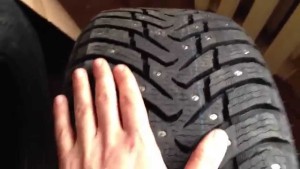Like most things, a studded tire can be carelessly ruined in a very short period of time. But with care, it can provide many years and many tens of thousands of kilometers of effective service. To achieve the latter, the tire must be broken-in properly, rotated correctly, and driven in a reasonable manner.
The break-in process begins the moment you begin rolling on a new set of studded winters. The studs need to be fully and firmly embedded in their final positions before experiencing any extreme forces that may loosen them. Avoid fast acceleration, hard braking, and high speeds for the first 500 km, especially the first 100 km. Basically, the newer the tire is, the more gentle you should be with it. Avoiding high speeds will be beneficial to the tread and studs throughout the life of the tire, but is especially important when new.
Studs will embed themselves a certain way depending on direction of rotation. Changing the rotating direction changes the forces on the studs and forces them into a different position, loosening the stud. To avoid this, always maintain the same rotating direction of studded tires, even on non-directional tread designs. Rotate from front to back only. Upon removal for summer storage, use a paint or tire marker to clearly mark the position or direction of travel on the inside sidewall to ensure they never end up on the wrong side.
Even after the tire is broken in, avoid unnecessary skidding, brake locking, or wheel spin any time that the stud is in contact with pavement. The abrasion of the pavement will wear down the stud pin and can sometimes even break it. However, aggressive acceleration, cornering, and braking does not necessarily cause excessive stud wear. Drive to the traction limit of your tires as much as possible if you enjoy that – I certainly do – but avoid exceeding that limit too often if you want your studs to last.

I just realized that I haven’t been paying attention to the directional rotation of the Cooper Discoverers for my ’99 Pathfinder. Perhaps I got lucky and got the direction right but it’s too late now as I’ve already put on several hundred kilometers on them. Next spring I will remember to mark the L and R side tires.